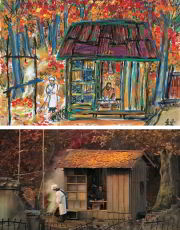 There is an absolutely fascinating website called This Must Be The Place, where the author has posted a series of pictures of Akira Kurosawa’s paintings side by side with screenshots of relevants scenes from his films. It’s nothing short of brilliant, if you ask me.
There is an absolutely fascinating website called This Must Be The Place, where the author has posted a series of pictures of Akira Kurosawa’s paintings side by side with screenshots of relevants scenes from his films. It’s nothing short of brilliant, if you ask me.
As some may remember, this is something that also I wanted to do years ago, but was quickly (in a matter of hours after posting!) sent a cease and desist letter by a company that back then held the license to all reproductions of Kurosawa’s paintings and drawings. They argued that my 300 pixels wide jpg images were hurting their business, so I had to remove the images and forget about a page dealing with Kurosawa’s paintings.
To be honest, I can perfectly well understand and accept their reasoning, and they were nice enough to discuss it with me and allow me to post some reproductions, albeit with an ugly “sample” text over them. Yet, I still remain a little bitter about the whole thing after all these years. I’d love to discuss Kurosawa’s paintings in more detail, and their relationship with the films, but this one experience showed me that there be dragons in that direction.
Which makes This Must Be The Place all the more lovely. I hope that s/he gets to keep the scans online, but in case that won’t be the case, hurry up to see the pictures!






Actually, those of you formally trained in visual arts (yes Coco, I’m looking at you), I would love to hear your opinion about Kurosawa as a painter. In terms of technique and skill, how was he?
Of course, most of the paintings and drawings that we have from Kurosawa are to a very large extent preparatory exercises for his films, so I’m not sure how fair it is to judge him as a painter based solely on those works. But at least Kurosawa seemed to have a fairly strong personal style, and it is one that I quite like myself.
Based on the works that we have available to us, do you think that Kurosawa could have made it as a painter, had he not become a filmmaker? This is of course not just a question for Coco — as always, I’d love to hear everyone’s opinions.